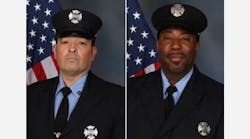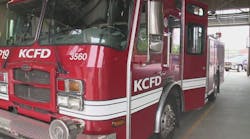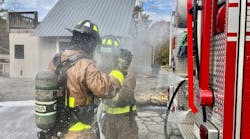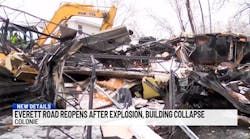As I sat in church a while ago, the sermon of the day once again caused my mind to go spiraling off into a world populated by my imagination and my demons. The message dealt with the impact of the Spirit on the believer. Inspiration leads to belief. I believe that is what I heard. My mind began to move, as it always does, toward the fire service, the center of my universe. How can the fire service to be guided by the spirit of effective leadership?
I believe that great leaders inspire us. It is my belief that these leaders ignite within us a spirit, if not a zeal that allows us to explore the boundaries of our own personal capabilities and limitations. These people create within us a desire to be more and to do more than we ourselves believe is possible. These leaders also have great expectations for us. They set goals for each of us that seem difficult to reach. They do this to stretch the boundaries of our capabilities.
The greatest of the great in the world of leadership are perceived that way because of the results they have been able to generate through their team. As my dear friend Alan Brunacini has often told me, it's all about the people in the organization. I believe that without willing followers, no leader in the history of the world would ever have succeeded in their drive for greatness.
The Phoenix Fire Department has succeeded because of an environment where teamwork is encouraged, and active participation is expected. Chief Brunacini has been able to field an outstanding team over the years because he has created within his mind a vision of what a good team should look like. He has then passed that vision along in an easily understood manner.
The vision was created based on the environment of that agency. The expectations were based on the reality that he knew he had to operate with. The people were a given. He knew he had to work with the human tools provided to him by the system. People were challenged to expand themselves. This was done in order to assist in creating the new reality of the organization.
Members have been allowed to grow in ways that benefit the team. However, these folks have performed in an outstanding manner because they wanted to. They perceived that the wanted to be members of the team. They also knew that excellence was the expected standard. They knew what membership of the team required. They knew this because the chief's vision was communicated to the in the same simple, but straightforward manner for which he has become so famous.
I can hear you all out there now. Oh that's Phoenix, and that's Brunacini. None of that stuff would work here, because everything we do is unique here in the Fort Fictitious Fire Department (F-Troop). Do you realize how patently ridiculous that statement is?
The world has existed for millions of years. Civilized society has existed in one form or another for centuries. How can anything be unique to anyone in the year 2003? I would suggest that the time is long past for us to concentrate on the development of each and every one of the fire departments throughout the United States and Canada, and on around the world. Get off your butt and generate a modern thought.
The organizational mindset within far too many fire departments was formed sometime during the Eisenhower administration (1953-1961, for you kids out there). Some of you might be lucky to have late Lyndon Johnson or early Richard Nixon era thinking, versus Eisenhower or even Truman thinking.
Older members among us have passed their thoughts along from generation to generation. These thoughts have grown sacrosanct with time and become the stuff of crusty old traditions. I am tired of hearing about people refer to their traditions as though they were somehow cast into the form of stone tablets by the Lord himself. Sorry gang, Moses had the production rights to that one.
Organizations must create an environment that can be explained to contemporary people in simple terms. If these people are to be molded into a form that will serve the organization, they must be able to understand why something should be done. The truly effective leader must have that skill.
In my last column I blasted the We've Always Done It That Way Warriors for their fanatical devotion to the status quo. There is nothing wrong with new thinking and new ideas. We would still be hitching our steamers to a team of horses were it not for the invention of the horseless carriage. I can only imagine the battles that went on between the proponents of the horse and the supporters of that newfangled contraption with a motor in it. If fire people then were like fire people now, it must have been a real tough time for all concerned.
My generation went through the same sort of battle over the issue of riding on the tailboards of our pumpers. I can recall people calling me a sissy for wanting to ride in a seated and belted position on our equipment in Newark. What they did not know was that I fell off of the tailboard of a U.S. Air Force fire department pumper in 1967. I know how much it hurts to hit the pavement and bounce. Tough guys rode the back step (truck guys rode the turntable or hung onto the bars on the sides of the tractor-trailer aerial ladders). Some of us even got to hang on the loops back near where the tillerman rode.
Over time, wiser heads prevailed. Of course those wiser heads frequently prevailed after they had their not-so- wise butts kicked in a court of law. Once again, many of these people were dragged kicking and screaming to a position of wisdom. This happened much sooner in those agencies where a forward-thinking leader was in the seat of command.
Chief Joe Redden was just such a leader. He was the fire chief in Newark when I joined in 1973. Many of you may remember him during his tenure with the National Fire Protection Association. Chief Redden saw the need to get us off of the back step in the early 1970s. Beginning in 1974, our apparatus was purchased with jump seats. The hard part was getting the troops to ride in the seats. But he persisted and we eventually did just that. He caused the rules to be created that made it possible for the department to operate more safely. Many people had to be made to understand that their behavior had to conform to the organizational norms. This requires constant effort on the part of people in positions of leadership at every level of the organization.
When the workplace environment of safe practices nudges the concept of unsafe out of the way, people can begin to buy in to the new environment. This leaves no room for naysayers. The wise leader must create an aura of understanding that specifically states that the way we did things in the past is not more. Once this new reality is made the norm, the organization will be that much the better for it.
This type of enlightened organization develops best in an environment where people are allowed to try, time and again, with the support of an organizational safety net. If you let people try, fail, try, fail and then try and try again with success as result, they will grow. This directed and supportive form of leadership builds a strong and supportive corps of followers.
In the absence of the perpetual threat of punishment, your people can develop into better organizational members. If you smack people down every time they fail, they will stop trying. They can then proceed to use the knowledge gained as a result of the failure to pursue a successful path. Members of the fire department will grow and prosper if you nurture and care for them. This leads to a better, more effective organization.
Effective leaders recognize that people are the heart of their organizations. These leaders challenge their team members to grow. They support their efforts. Should failure occur, they pick their troops up, dust them off, and then give them the means to try again. When their team members are successful, they stand back and let their people bask in the warm glow of success.
These fine leaders never step forward, push their people out of the way and take the credit for every success. They introduce their people, praise them publicly and step toward the background and let the warmth of the glow wash over them by reference.
That is they way it is in Phoenix. Every time one of Chief Brunacini's team receives an accolade, I know that he truly takes pleasure in watching them enjoy their success. Those of us in the rest of the fire service world know that the success experienced by these people was due in great measure to the environment in which they work.
Be warned. I am not suggesting that you let people run amok. I am advocating enlightenment, not chaos. We still need rules, regulations and discipline. But we do not need to smack people just for trying and failing. Where might we today be if the first people to attempt the use of a motorized tractor to pull an aging steam pumper had failed and been punished so devastatingly that they gave up hope? Never forget that many of life's greatest successes have come about as a result of failures.
Wise leaders understand that. In that way they can craft an organizational environment wherein they can mold capable disciples. I suggest that this will work just as well for you as it has worked for Chief Alan Brunacini.
Harry R. Carter, Ph.D., MIFireE, is a Firehouse® contributing editor. A municipal fire protection consultant based in Adelphia, NJ, he is a former president of the International Society of Fire Service Instructors (ISFSI). Dr. Carter is an associate professor at Mercer County Community College and a past chief and active life member of the Adelphia Fire Company. A fire commissioner for Howell Township District 2, he retired from the Newark, NJ, Fire Department in 1999 as a battalion commander. He also served as chief of training and commander of the Hazardous Materials Response Team. Dr. Carter is a Member of the Institution of Fire Engineers of Great Britain (MIFireE). You can contact him through his website at [email protected].




